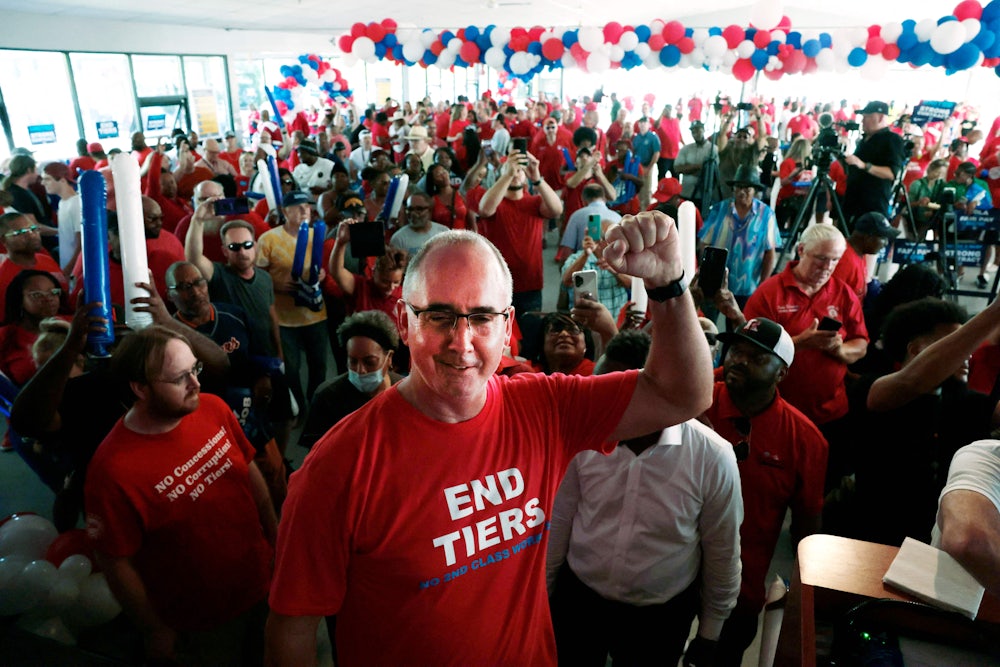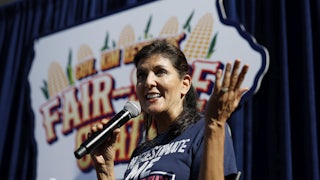Labor Day may be September 4, but it will remain summer, and therefore Hot Labor Summer, until the September 23 autumnal equinox, by which time the United Autoworkers (UAW) may be on strike. UAW workers last week voted overwhelmingly to authorize strikes at Ford, GM, and Stellantis (the Big Three auto manufacturer formerly known as Fiat Chrysler), and if negotiators don’t agree on a contract by September 14, says UAW President Shawn Fain, 150,000 workers will walk off the job.
Born into a union family—three of his grandparents were auto workers represented by the UAW—Fain started as an electrician for Chrysler in Kokomo, Indiana. He held a variety of positions in UAW’s Kokomo local where, according to his official UAW biography, he was often “ostracized for speaking up,” then moved up to the international union. Fain was elected UAW president in March, in an upset victory over incumbent Ray Curry, after pledging to clean up and re-invigorate the scandal-plagued union, which sent two former presidents to prison for embezzlement. Fain is the first UAW president ever to be elected directly by the rank and file instead of by convention delegates, a procedural change initiated by a 2021 consent decree with the Justice Department to resolve the corruption scandal. I caught up with Fain by phone Wednesday as he was en route to Lansing, Michigan, to attend a speech by Gov. Gretchen Whitmer.
I began by asking how negotiations were going. Slowly, Fain answered. “We’ve given our demands up front,” he said. Management’s strategy, Fain said, is to “slow walk everything,” much as they’ve done in the past under similar circumstances.
When Fain, in early August, outlined the UAW’s contract demands for the Big Three, he called them “audacious.” They live up to that billing. The UAW seeks a 40 percent pay hike over four years, a 32-hour work week at full pay, the elimination of a two-tier wage structure initiated during the Great Recession as GM and Chrysler were going bust, and restoration of defined-benefit pensions for new hires that the UAW gave up in 2008 to help secure the Obama administration’s auto company bailout.
“We have a tradition in this union of aiming low and settling lower,” Fain said. “We have to get away from that.”
The 40 percent increase, Fain said, would catch up workers, after inflation, to what they were making in 2007. And anyway, he said, CEO pay at the Big Three rose 40 percent over the current four-year contract. (That’s about right, according to the Detroit News; GM’s Mary Barra is up 34 percent since 2019.) Fain won’t get UAW workers 40 percent, but it’s a defensible (if audacious) negotiating position.
The 32-hour week? “If Covid taught us anything, it’s that our time is very valuable,” he said. Why should it be OK for white collar workers to cut back hours by working at home, he said, but “obscene” when auto workers demand shorter hours?
The two-tiered wage structure? Variations have existed since the 1980s, when domestic auto manufacturers were rapidly losing ground to foreign manufacturers. Why eliminate them now? Because they’re divisive, Fain said, and anyway, UPS recently got rid of theirs.
Defined-benefit pensions? Aren’t generous pensions a thing of the past? Not for Big Three executives, Fain said. (See my May TNR article on special “top hat plans”—that’s actually what they’re called—available exclusively to corporate big shots.) Fain reminded me that in 1949 former UAW president Walter Reuther (“the most underappreciated American in American history”) secured defined-benefit pensions for retired auto workers with the slogan “too old to work, too young to die.” That hasn’t changed.
I asked Fain about reports that the UAW is withholding its expected endorsement of President Joe Biden, with whom Fain met in July. “It was a good meeting,” Fain said, but “we’ve made it clear that our endorsements are going to be earned, not freely given.” The Biden administration, which issued a report earlier this week touting the benefits of union representation (“Labor Unions and the Middle Class”), dodged a bullet during the past year averting threatened strikes by rail unions, west coast port workers, and United Parcel Service (UPS) drivers. It could use an autoworkers’ strike like a hole in the head.
The Inflation Reduction Act introduced tax credits that prompted, by the end of 2022, a $73 billion investment in United States plants to manufacture batteries for electric vehicles. The Big Three are forming partnerships with other companies to build batteries, and they’ve signaled they’re willing to hire union labor. But Fain says that’s not enough. “The battery work, specifically, that’s the future power train of the automobile,” he said. That power train right now is built by workers covered by the UAW contract. Its replacement, he said, should be built by workers covered by the same contract. “We stand to lose 20 percent of our workers” to battery production, Fain said. “It has to be a just transition.”
I asked Fain more broadly about how to revive the union movement. This Labor Day unions are more popular with the public than they’ve been in 60 years, and strike activity is way up, but the proportion of private-sector workers who belong to a union has fallen to an objectively dismal 6 percent. Fain didn’t try to explain that away, as some labor leaders do. When I asked him about the NLRB’s Cemex decision last week, which will make it easier to organize workplaces through the informal collection of union authorization cards (“card check), he said it’s a “good start.” But “the Democratic Party has to get back to its roots,” he said. He meant its working-class roots. Still, Fain is optimistic. “There can be a great revitalization of labor,” he told me. If there is, I predict Fain will play a big part in the transformation.






